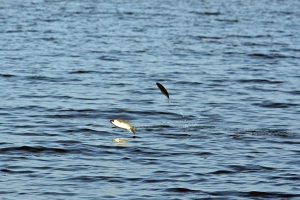
Courtesy, State Archives of North Carolina
In the autumn of 1938 a photographer named Charles A. Farrell visited a seasonal mullet fishing camp at Brown’s Island, in Onslow County, N.C. What he discovered there captured his imagination: a remote hamlet of fishermen’s shanties far from civilization and two legendary clans of fishermen in pursuit of one of the Atlantic’s great schooling fishes, striped mullet.
“Jumpin’ mullets,” people here call them.

Striped mullet, a.k.a. jumping mullet or, around Wilmington, pop-eyed mullet
Neither of the two clans, the Gillikins or Lawrences, came from the mainland nearest the island. Instead, they traveled by boat there in the fall of the year from Otway, a small farming and fishing community in Carteret County, 40 miles to the east. Year after year for generations, the men left their homes in Otway and returned to Brown’s Island and the sea.
Farrell’s photographs provide a unique portrait of mullet camp life and an invaluable historical record of one of the largest commercial fisheries in the American South.
For the next 2 weeks, I’ll be featuring Charles Farrell’s photographs from Brown’s Island, in Onslow County, in 1938. An earlier version of this story appeared in Southern Cultures, a quarterly journal published by the UNC Center for the Study of the American South.
For much of the 19th century, the mullet trade on the North Carolina coast comprised the largest saltwater fishery in the South. Even as late as the 1930s, large numbers of fishermen still moved to the barrier islands every autumn to work out of camps like the one at Brown’s Island. From Ocracoke Inlet to Cape Fear, their camps lined the shores.
Centered at Morehead City, N.C., fish dealers loaded so many barrels of salt mullet on outbound freight cars that local people referred to the railroad as “the Old Mullet Line.”
During the late 1930s, Farrell documented fishermen’s lives in a large swath of the North Carolina coast, as well as at Brown’s Island. The son of an itinerant daguerreotypist, he was the proprietor (along with his wife) of an art supply store and photography studio in Greensboro, N.C.
But Farrell had long had a special interest in the lives of commercial fishermen. He frequently visited the coast, and he had a gift for recording scenes of village life and daily work that other photographers (outsiders and locals) deemed unworthy of their attention because they were too ordinary or too unromantic.
As a result, Farrell’s photographs often provide a rare record of some of the most typical scenes of coastal life in the 1930s.
Farrell had hoped to publish his photographs in a book, but he had serious health problems in the 1940s and never made much headway. However, his photographs can now be found at the State Archives of North Carolina, and you can even download copies of them from the State Archives’ wonderful flickr site, too.
You can also learn more about Farrell’s life in his personal papers that are preserved at the Greensboro History Museum’s archives and at the Southern Historical Collection at UNC-Chapel Hill.
I’ll be posting his photographs from several coastal villages in the coming months, but today I’m starting with his photographs of the mullet fishing camp at Brown’s Island in 1938. I’ll be posting one new photograph and the story behind it every day for the next two weeks!
Today’s photograph is an early morning view of the Brown’s Island mullet camp. You’re seeing the camp at low tide from a dock on the sound side of the island. One of the oldest mullet fishermen, Bedford Lawrence, walks down the dock in a farmer’s coat and sou’wester. A clinker-built boat is tied by its anchor line to a post on the left side of the dock, a flat-bottomed skiff on the other side.
A sizable portion of the camp can be seen behind Lawrence: wooden tables for cleaning the fish; salting trays; empty barrels and kegs for packing salt fish; and a few of the fishermen’s cabins. An open shed for storing gear and barrelfuls of salt mullet and spots stands on the far right.
Two of the camp’s hogs, a pair of cats, and a goat are finishing off leftovers from the fish cleaning tables. Another hog has found something interesting next to the shed.
Roughly four miles long, with an ocean beach facing southeast, the island was only a few hundred yards wide next to the inlet, where the camp was built: the ocean beach lay just beyond the high dunes in the distance.
Tomorrow– a view of the mullet camp’s cabins and the “Big Ditch”

Jumping mullets doing what they do
For deepening my understanding of Farrell’s photographs from Brown’s Island, I’d like to thank the following people: Mike Alford, Elise Allison, Karen Amspacher, Kim Andersen, Larry Babits, Dennis Chadwick, the late Ellen Cloud, Roger Farrell, Michael Fulcher, Paula Johnson, Joel Hancock, Patricia Hughey, Pam Morris, Rick Searles, Mathew Turi, Alison Walker, Ryan Walker, Lisa Whitman-Grice and Ginny Williamson. I would also like to extend a special word of thanks to Rodney, Norwood and Henry Frost for discussing the photographs with me at Salter Path, N.C., and to all the descendants of the Brown’s Island mullet fishermen who gathered at the community supper on Harkers Island, but most especially Mr. H. B. Lawrence.
Thank you David for sharing your discoveries with us. I am excited that I might see my ancestors & show my granddaughters.
LikeLike
Pingback: The Herring Workers | David Cecelski
Pingback: Our Coast’s History: The Herring Workers - OBXNews.Live